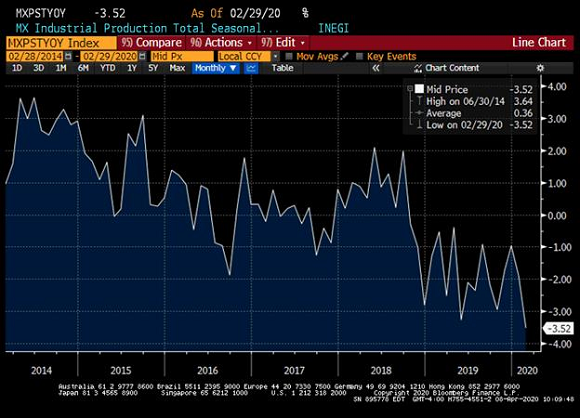By Natalia Gurushina, Economist, Emerging Markets Fixed Income, VanEck Global
Poland surprises with a 50bps rate cut, expressing concerns about companies’ future place in global value chains. Mexico’s activity was already weakening going into the crisis, which calls for additional policy support.
Emerging markets (EM) continue to line up additional stimulus, and today’s installment includes a surprising 50bps policy rate cut in Poland, with the central bank promising to do “whatever it takes” to combat the crisis and boost growth. The government is in a similar mood, expanding its fiscal stimulus to ~14% of GDP (one of the largest in EM)—so the central bank’s newly-minted bond-buying program comes in very handy. One interesting comment that Governor Adam Glapinski made this morning is that it is very important for Polish companies to retain their place in global value chains. This echoes concerns expressed by other EM policy-makers that the global geopolitical situation might be very different when the crisis is over—especially as regards reassessment of global value/supply chains and how this can affect EM.
Mexico’s latest industrial production (IP) print showed why the market was disappointed with the government’s crisis package. The IP growth was already weakening going into COVID-19, with yearly contraction deepening to -3.52% in February (see chart below). One silver lining here is that much weaker domestic demand should keep inflation pressures capped for the foreseeable future, which leaves room for additional policy monetary support in the form of rate cuts. However, the central bank can do only that much, so the pressure on the government to step up its own stimulus is likely to persist.
Even though the policy focus in EM is mostly on anti-crisis measures, we keep an eye on several structural cliffhangers, especially in Ukraine and Peru. Today’s newsflow from Ukraine was not too encouraging, as the second vote on the vitally important banking law might take much longer than expected. In Peru, the issue at stake is the congressional decision to let people withdraw up to 25% from their private pension accounts, which can impact the local bond market. The bill is with President Martín Vizcarra right now, who is expected to meet with congressional representatives.
Chart at a Glance: Mexico Activity – Calling for Extra Policy Support

Source: Bloomberg LP
IMPORTANT DEFINITIONS & DISCLOSURES
PMI – Purchasing Managers’ Index: economic indicators derived from monthly surveys of private sector companies; ISM – Institute for Supply Management PMI: ISM releases an index based on more than 400 purchasing and supply managers surveys; both in the manufacturing and non-manufacturing industries; CPI – Consumer Price Index: an index of the variation in prices paid by typical consumers for retail goods and other items; PPI – Producer Price Index: a family of indexes that measures the average change in selling prices received by domestic producers of goods and services over time; PCE inflation – Personal Consumption Expenditures Price Index: one measure of U.S. inflation, tracking the change in prices of goods and services purchased by consumers throughout the economy; MSCI – Morgan Stanley Capital International: an American provider of equity, fixed income, hedge fund stock market indexes, and equity portfolio analysis tools; VIX – CBOE Volatility Index: an index created by the Chicago Board Options Exchange (CBOE), which shows the market’s expectation of 30-day volatility. It is constructed using the implied volatilities on S&P 500 index options.; GBI-EM – JP Morgan’s Government Bond Index – Emerging Markets: comprehensive emerging market debt benchmarks that track local currency bonds issued by Emerging market governments.; EMBI – JP Morgan’s Emerging Market Bond Index: JP Morgan’s index of dollar-denominated sovereign bonds issued by a selection of emerging market countries; EMBIG – JP Morgan’s Emerging Market Bond Index Global: tracks total returns for traded external debt instruments in emerging markets.
The information presented does not involve the rendering of personalized investment, financial, legal, or tax advice. This is not an offer to buy or sell, or a solicitation of any offer to buy or sell any of the securities mentioned herein. Certain statements contained herein may constitute projections, forecasts and other forward looking statements, which do not reflect actual results. Certain information may be provided by third-party sources and, although believed to be reliable, it has not been independently verified and its accuracy or completeness cannot be guaranteed. Any opinions, projections, forecasts, and forward-looking statements presented herein are valid as the date of this communication and are subject to change.
Investing in international markets carries risks such as currency fluctuation, regulatory risks, economic and political instability. Emerging markets involve heightened risks related to the same factors as well as increased volatility, lower trading volume, and less liquidity. Emerging markets can have greater custodial and operational risks, and less developed legal and accounting systems than developed markets.
All investing is subject to risk, including the possible loss of the money you invest. As with any investment strategy, there is no guarantee that investment objectives will be met and investors may lose money. Diversification does not ensure a profit or protect against a loss in a declining market. Past performance is no guarantee of future performance.







